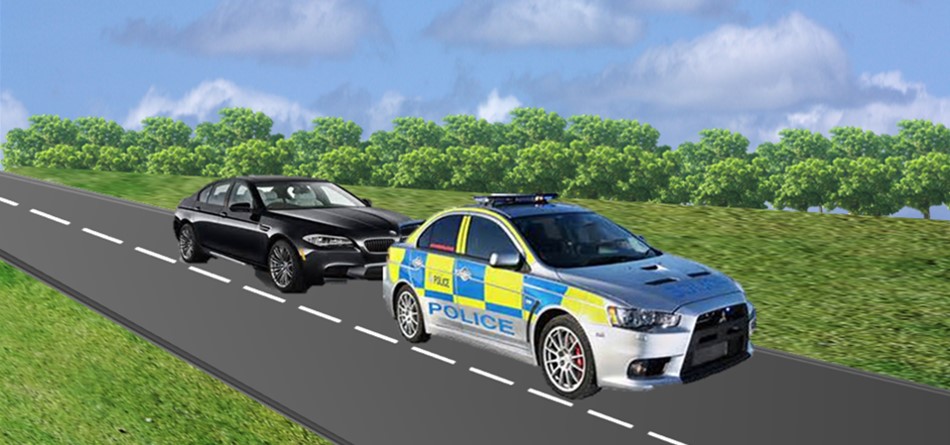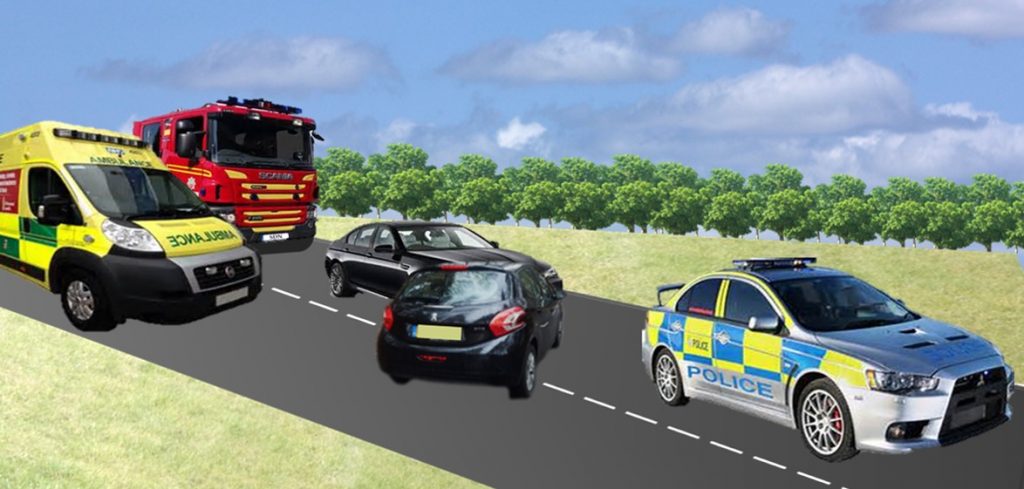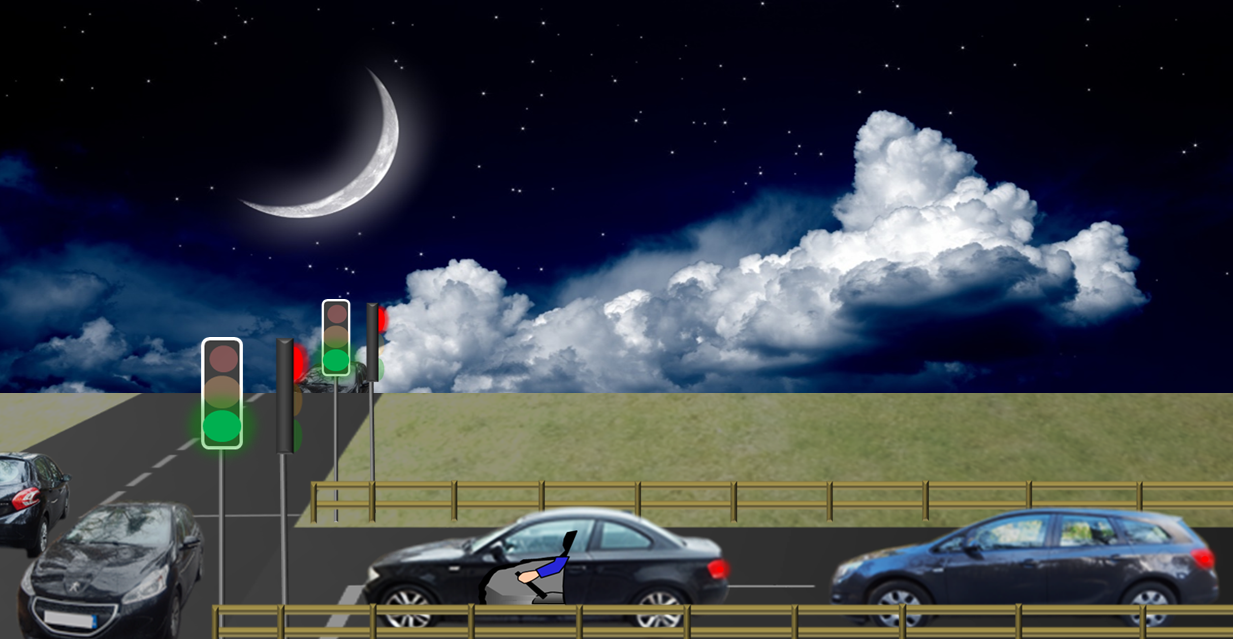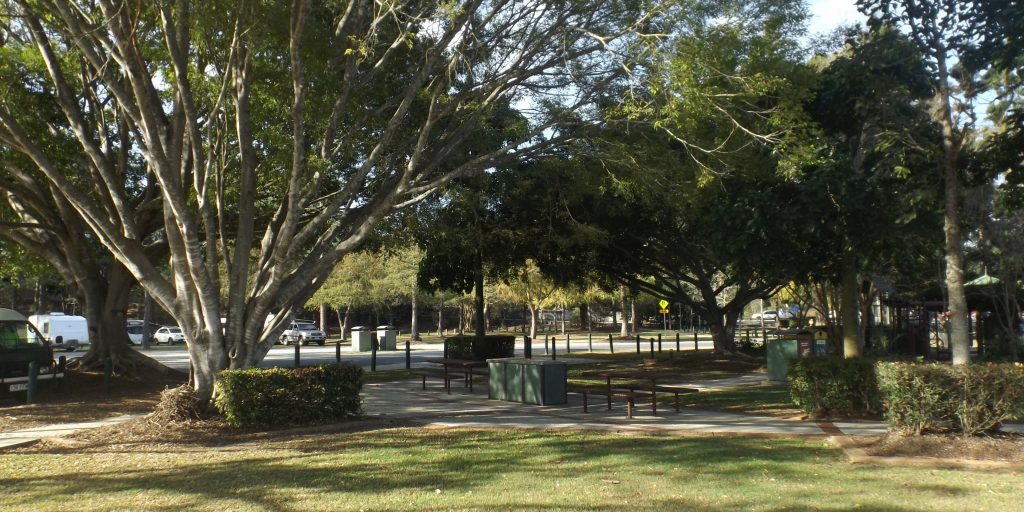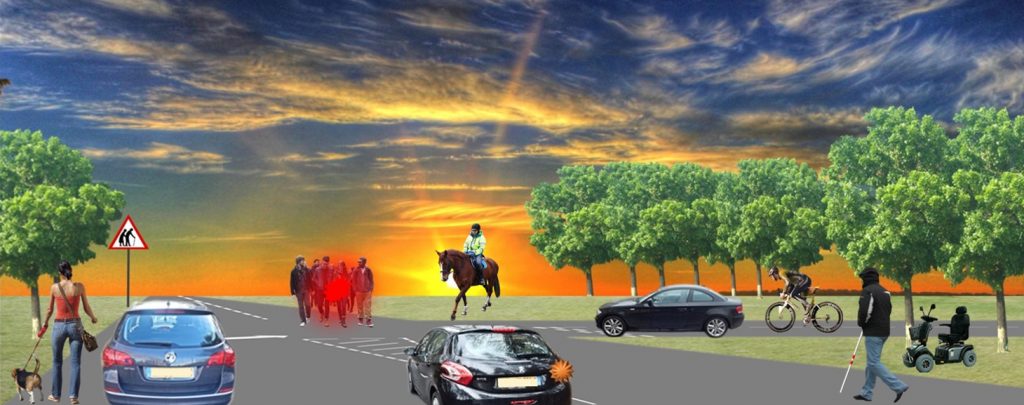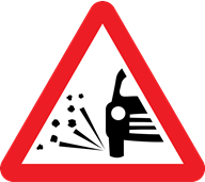Attitude & Alertness

This section covers attitude the procedures that must be carried out by you the driver. It is important for you as a driver to be aware of your actions on the road and how the decisions you make impact other road users. Exceeding speed limits and a lack of consideration for other road users is the most common cause of all road traffic accidents.
[su_youtube url=”https://youtu.be/857yqlY_gjE”]
TRAILER SWING
Trailer swing can be caused by several factors, one of the most common causes is the instability of your load. You must make sure that the load is evenly placed on the trailer and you keep to the speed limits. If you are unfortunate enough to experience trailer swing do not brake immediately as you will risk losing control.
Ease of the accelerator until the trailer has regained stability then stop at the next convenient place and check both trailer and load.
As you can see from the picture trailer swing will cause problems for other road users.
AQUAPLANING
Aquaplaning is when your vehicle tyres lose contact with the road surface, this is generally caused by excessive speed in relation to road conditions. Your tyres are not capable of dispersing the surface water causing a film of water building up between the tyres and road surface.
You will lose control of the vehicle and could cause a major accident. If you find yourself in this situation do not brake as you will cause your vehicle to go out of control. Remove your foot from the accelerator. When you have regained control test your brakes if it is safe to do so as they could have become wet which would reduce your brakes effectiveness.
Uneven road surfaces can cause surface water to accumulate causing the situation with very little warning. Slow down irrespective of the speed limit. Driving too fast on wet surfaces can also result in you splashing pedestrians, no you do not accumulate prize points for doing this but you can accumulate penalty points, you could even find yourself wearing your best suit when attending court for actual bodily harm.
FORD
A ford is a small stream that naturally crosses a road. These can be found in rural areas. As you can see from the picture it will have a depth gauge and the appropriate warning signs. After heavy rain the depth of water can increase and if not approached and driven through carefully you could damage your vehicle. In the winter months, the water could freeze giving you a different problem.
After driving through a ford use the foot-brake and accelerator together, the heat generated will help dry your brakes.
CONSIDERATION
Some roads in rural areas will at times become very narrow, even though they are two way roads you will find it very difficult to pass oncoming traffic safely.
There are passing places as shown in the picture to your below, be prepared to give way and use them.
You may need to reverse into them, always be polite and show consideration for other road users.
You are approaching a hill, there are parked cars on the right-hand side of the road, the speed limit is 40 mph and the warning sign tells you that you are approaching a steep hill.
Prepare your vehicle for the hill by selecting the appropriate gear, be prepared to slow down and give way to vehicles coming up the hill even though it is your right of way.
Where you can, give way to large goods vehicles, if the vehicle loses its momentum it could be difficult for the vehicle to start moving again.
On approach to an arched bridge similar to the one in the picture below, you could possibly meet a large goods vehicle or coach in the middle of the road. Be prepared to stop and give way.
THE POLICE
The police can stop you at any time, it is generally because they have seen a fault on your vehicle, their intervention could help you avoid a situation later. Your brake lights may not be working which could cause problems for following vehicles. The Police will also stop you if they have seen you committing a motoring offence.
When they stop you, they will notify you of their intentions by signalling left and pointing to the left.
They will check your documentation, if you do not have the requested documents with you they will issue you with if necessary a seven-day producer.
You must produce the documents they have asked for at a police station within seven days.
ACCIDENT
If you are involved in a road traffic accident (RTA) you must try to keep calm, if you are uninjured your priority is to assess the situation, prevent further danger and tend to any injured.
Some RTA’s do not require the intervention of the emergency services, they must be reported within 24 hours if damage to property has been caused or slight injuries to individuals. You must also report it if you have struck a dog.
All emergency vehicles will display blue or green flashing beacons, it is important that you the driver know what to do if you are being followed by these vehicles when operating their lights. Most importantly do not panic, more importantly do not stop, assess the situation first. stopping in the wrong place could delay the emergency services.
If it is not possible to let the pass safely drive normally and pull over when it is safe to do so.
In addition to the police, fire and ambulance services, there are other emergency services that display blue flashing beacons:
BOMB DISPOSAL
MOUNTAIN RESCUE
BLOOD TRANSFUSION VEHICLES.
Doctors on call will display green flashing lights.
Other services will display flashing amber beacons such as highway maintenance, traffic officers and breakdown recovery vehicles. There is also a requirement for all slow-moving vehicles to display these beacons such as: road sweepers, tractors and invalid carriages. As a driver, always be courteous and considerate and give way when safe to do so if necessary.
BASIC FIRST AID
After making the scene of an accident safe and you have assessed the situation you may need to provide immediate first aid before the emergency services arrive. You must assess the injuries to third parties. With any casualty, the first thing that must be assessed is whether they can breathe un-aided. A simple rule is airway, breathing and circulation (ABC). Once you have 
assessed an individual that is lying on the ground and established that they are breathing, you should put them into the recovery position as long as there are no obvious signs of any injuries and you do not suspect any potential injuries including spine or neck injuries.
If you find that a casualty is not breathing you may need to deliver CPR until the emergency services arrive or the casualty can breath un-aided. Do not panic. First Aid is defined as the first assistance or treatment given to a casualty for any injury or illness before the arrival or intervention of qualified professional aid. Before you start ask any bystanders if they have any experience in CPR so they can assist.
If you are delivering CPR to a child make sure that the rescue breaths are gentle
BURNS
If there are any casualties with burns the general treatment is as follows:
Cold water is run gently over the area for at least 10 minutes until heat and pain are relieved (20 minutes for chemical burns). Immersion of the burnt area in a bowl of water can also be used if practical.
Cover loosely with sterile dressing, plastic bag or kitchen cling film.
Burns to the eye – flush with water for 10 minutes.
Do not rip of any stuck burnt material as this can cause further injury.
Do not apply any ointment as this can be a problem later and can cause infection.
OPEN WOUNDS
If a casualty has external bleeding and you do not have a first aid kit you must:
1.Apply direct pressure.
2.Elevate if possible.
3.Treat for shock.
SHOCK
For any casualty suffering from shock, you will be required to carry out the following treatment:
1.Lay the casualty down, elevate legs – this ensures blood flow to the major organs is maintained.
2.Give nothing to eat, drink or smoke.
3.Treat any obvious cause, it may be a simple case of turning the casualty away from a distressing scene.
4.Keep warm and comfort until help arrives and provide reassurance.
DRIVING AT NIGHT
When daylight diminishes, it is important that you turn the appropriate lights on, generally dipped headlights, this will also display red rear tail lights allowing you to be seen. If you are using full beam headlight be prepared to dip them for approaching traffic, failure to dip them could result in a RTA as you could possibly blind the oncoming driver.
If you find yourself being dazzled by oncoming traffic, slow down until you can proceed safely. If a vehicle behind you has full beam lights on this can affect you as the lights will reflect off your centre rear view mirror. If this happens you can apply an anti -dazzle device fitted to your mirror. Stay calm and do not retaliate.
If you look at the picture above the switch at the bottom of the mirror circled red changes the angle of the mirror reducing dazzle from the vehicle behind.
Its called the anti-dazzle switch (device). On newer vehicles the interior mirror will dim automatically.
BRAKE LIGHTS
Brake light are very bright, they have to be to warn other traffic of your actions. Brake lights can also pose a problem when your vehicle is stationary. At night the light given of from your brake lights can dazzle other road users. When waiting at traffic lights put your parking brake (hand brake) on and release the foot-brake, otherwise you will be dazzling drivers behind you with your brake lights.
When sat in stationary traffic it would be considerate to other road users to carry out this procedure.
ALTERNATIVE SIGNALS
To help other road users understand your intentions other than using the indicators and lights fitted to your vehicle you can in addition use arm signals. These are very useful when you are in heavy traffic, warning overtaking vehicles such as motorbikes that cannot see your lights you are turning or slowing down.
You can also warn other traffic that you are slowing down by the temporary use of your hazard warning lights.
BLIND SPOTS
The door pillar is not the only obstruction to your vision when driving, the mirrors on your car do not give you an overall view of what is around you. Your mirrors only cover a certain amount of the immediate area around you. The areas not covered by your mirrors are classed as blind spots.
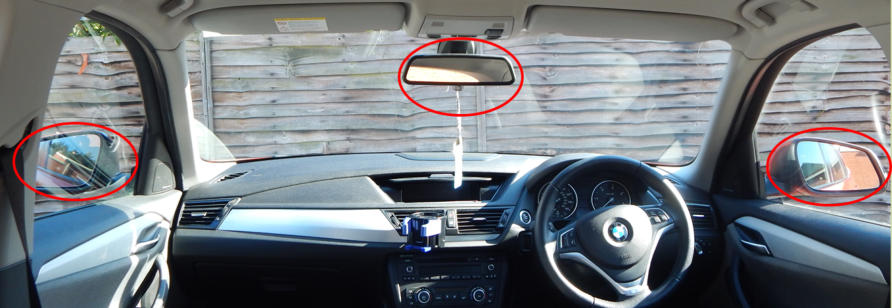 The picture above shows the mirrors that are available to you for immediate observation, but that view does not give you a true picture of what is going on. If you do not turn your head to cover the other areas you will be putting vulnerable road users at risk.
The picture above shows the mirrors that are available to you for immediate observation, but that view does not give you a true picture of what is going on. If you do not turn your head to cover the other areas you will be putting vulnerable road users at risk.
The picture above shows one of the new manoeuvres that you will carry out on your driving test. You will be asked to drive into a parking bay, when reversing out of the bay all round observation is needed. I have positioned two people outside the field of vision of your mirrors, you can see they are very close to your vehicle but can not be seen in the mirrors.
Failure to check your blind spots will result in a test fail.
The individuals could be cyclists, children or the elderly. You must make blind spot checks when ever you move off or change lanes.
MOBILE DEVICES
When you can use a hand-held phone:
You can use a hand-held phone if either of these apply:
•you’re safely parked
•you need to call 999 or 112 in an emergency and it’s unsafe or impractical to stop
Penalties
•You can get 6 penalty points and a £200 fine if you use a hand-held phone
You can also be taken to court where you can:
•be banned from driving or riding
•You can get a maximum fine of £1,000 (£2,500 if you’re driving a lorry or bus)
If you passed your driving test in the last 2 years, you’ll lose your licence.
If you are using a Sat Nav system, make sure that you have programmed it before you start your journey. Do not try and make changes whilst on the move. Stop in a safe place.
Position your Sat Nav so that it is not a distraction. It only takes a second to have an accident. When using your phone to navigate the same rules apply.
TUNNELS
When driving through tunnels you need to be aware of driving procedures.
Under normal conditions you will see blue fluorescent markers, these are there to help you judge your distance from the vehicle in front.
Try to keep two markers between you and the vehicle in front of you.
If you have to stop in a tunnel make sure that you have at least a 5 metre gap between your vehicle and the one in front.
You should keep this gap in any traffic queue just in case the vehicle in front will not start and you need room to get around it.
Tunnels are enclosed and the glare from your brake lights can be blinding.
If you find yourself in traffic queues in a tunnel, show consideration to others and apply your handbrake and release your foot-brake.Turn your engine off and get familiar with the emergency exits.
REST BREAKS
Road safety advisor’s state that when planning a long journey of five hours or more, you must factor in a break every two hours, it must be an un-interrupted break.
Stopping at level crossings or in traffic queues does not count. Driving fatigue is one of the biggest killers on Britain’s roads today.
Even though this is not law it is advice given in the highway code.
Failure to take one break can result in heart break.
VULNERABLE ROAD USERS
A group of pedestrians carrying a red light means it is an organised march or walk.
Sudden noise from your air brakes can cause the horse rider to loose control.
Pedestrians walking with flow might not hear or see you.
Cyclists and mopeds might suddenly change direction.
Mobility scooters are very slow, be patient. They are only allowed to travel at 8 mph on the road. They could cause pedestrians to move on to the road if they are using the footpaths, on the footpaths they can only travel at 4 mph.
Pedestrian using a white stick with red bands, means they are both deaf and blind.
Be prepared to slow down and stop for the elderly, their reactions are not as quick as they use to be.
Other road users

Trams can be quite dangerous, they can only travel in a straight line, they cannot steer around you. Trams run on electricity so they are extremely quite, they are good for the environment as they not only run on electricity they help reduce the amount of vehicles on the road. Be careful when cyclists are in the vicinity, they could easily fall of their bikes due to getting stuck in the rails.
Tractors also pose a problem, they are large and slow, they are supposed to pull over to let other vehicles pass, this does not happen. It often causes frustration to other road users, in some cases drivers make the wrong decision and overtake in dangerous situations.
Road works
Road works can be controlled by temporary traffic light and stop go boards, You may even see a person trying to direct traffic, be patient.
At certain times of the year the road surface will undergo a face lift, they are simply sprayed with a liquid tar and covered with loose stone chippings. It is important that you keep your vehicles speed to a minimum when passing others. there is generally a 20 mph speed limit. If you go to fast you could possibly damage other vehicles. Below is the Loose chipping warning sign.
Loss of Licence
Loosing your car licence will effect all of your categories, after serving a ban it is not as easy to regain your vocational licences, this is purely down to the traffic commissioner.
Driving under the influence of drink and drugs will result in hefty fines and even disqualification.
In England, Wales and Northern Ireland, the drink-drive alcohol limit for drivers is: 80mg of alcohol per 100ml of blood 107mg of alcohol per 100ml of urine 35 micrograms of alcohol per 100ml of breath.
You could be imprisoned, banned from driving and face a fine if you’re found guilty of drink-driving.
The actual penalty you get is up to the magistrates who hear your case, and depends on your offence.
You may get:
- 3 months’ imprisonment
- up to £2,500 fine
- a possible driving ban
You may be able to reduce your ban by taking a drink-drive rehabilitation scheme course (DDRS) if you’re banned from driving for 12 months or more. It’s up to the court to offer this.
A DG10 driving offence is committed when you drive, attempt to drive or are in charge of a vehicle on a road or other public place while being unfit to do so through drugs. Your ability can be impaired by prescription, over the counter or illicit drugs.
Punishments for DG10 driving offences
Penalties for DG10 offences include a mandatory 12 month disqualification. Those convicted could also face a low level community order – typically 40-80 hours unpaid community service – and a fine.
Convicted drivers will receive a minimum of three and a maximum of 11 points on their licence which will remain for 11 years.
The maximum punishment magistrates can impose is a six month prison sentence alongside a lengthy driving ban and/or an unlimited fine.
Loosing your licence in your first two years will mean re-applying and completing your theory and practical tests again.
Dangerous driving
The offence of dangerous driving under section 2 of the Road Traffic Act 1988 is committed when the defendant’s driving falls far below the standard expected of a competent and careful driver and it would be obvious that driving in that way would be dangerous – section 2A of the RTA 1988. If you are successfully prosecuted for dangerous driving within your first two years. When re-taking your practical test you may need to complete an extended test.
Some typical examples from court cases of dangerous driving are:
- Racing, going too fast, or driving aggressively;
- Ignoring traffic lights, road signs or warnings from passengers;
- Overtaking dangerously;
- Driving under the influence of drink or drugs, including prescription drugs;
- Driving when unfit, including having an injury, being unable to see clearly, not taking prescribed drugs, or being sleepy;
- Knowing the vehicle has a dangerous fault or an unsafe load;
- The driver being avoidably and dangerously distracted, for example by:
- Using a hand-held phone or other equipment
- Reading, or looking at a map
- Talking to and looking at a passenger
- lighting a cigarette, changing a CD or tape, tuning the radio.
- If you are prosecuted for dangerous driving







